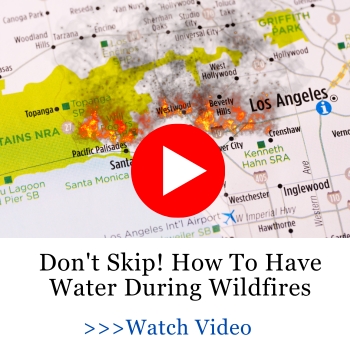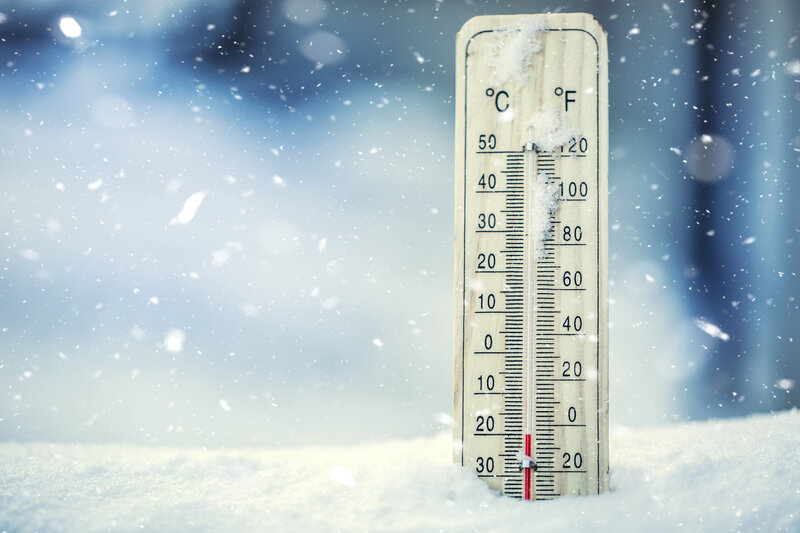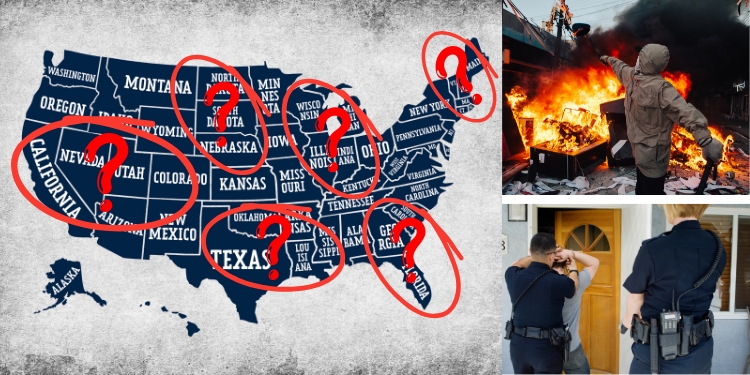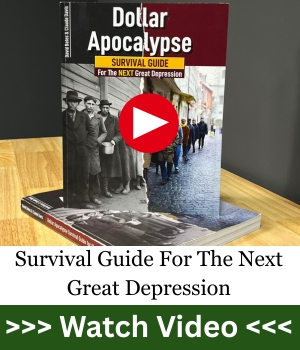When the grid goes down and chaos sets in, your location could mean the difference between survival and disaster. There’s no ideal place, when SHTF, but you want to know the harsh truth? Some states are practically death traps when it comes to bugging in. Overcrowded cities, crippling laws that strip you of your right to defend yourself, sky-high crime rates, and unforgiving weather, all of it can turn your so-called safe haven into a ticking time bomb. Let’s take a hard look at the worst states to bug in and find out if your home is already working against you.
California: The Red Tape Nightmare
 California may offer stunning views and sunshine but don’t let the scenery fool you. When crisis hits, this state becomes a nightmare for anyone planning to bug in. With some of the harshest laws in the country, your ability to defend your home could be crippled when you need it most. And in a state teeming with people, especially in urban jungles like Los Angeles or San Francisco, the scramble for dwindling resources will be ruthless. When millions are desperate, chaos isn’t just possible. It’s inevitable.
California may offer stunning views and sunshine but don’t let the scenery fool you. When crisis hits, this state becomes a nightmare for anyone planning to bug in. With some of the harshest laws in the country, your ability to defend your home could be crippled when you need it most. And in a state teeming with people, especially in urban jungles like Los Angeles or San Francisco, the scramble for dwindling resources will be ruthless. When millions are desperate, chaos isn’t just possible. It’s inevitable.
But the real danger doesn’t stop there. California is a tinderbox, and if a wildfire strikes, your well-stocked safe zone could become an inescapable inferno. Add to that the crushing weight of building codes, water restrictions, and sky-high taxes, and you’re left with a hard truth: California may look like heaven, but for preppers, it’s a trap waiting to spring.
If you want to increase your chances of handling wildfires effectively, it’s absolutely crucial to ensure you have access to a sufficient water supply. You should know that there’s this backpack-sized water generator out there that can that make almost 40 gallons of water per day. Out of thin air!
New York: Packed and Policed
What happens when the unthinkable strikes the heart of New York City? The moment disaster hits, the city becomes a trap. So many people crammed together in a concrete maze with nowhere to run. Streets choke with panicked crowds. Shelves empty in hours. Imagine being surrounded by desperate people, all fighting for the same dwindling resources. How long could you last?
Related: Pre-SHTF Mistakes That Might Get You Killed
And if you think you can defend yourself… Well, think again! New York’s strict gun laws leave you frighteningly exposed. When law enforcement is overwhelmed, and help is nowhere in sight, what options do you really have to protect your family? Then there’s the cold. Brutal winters combined with a shaky power grid can quickly turn your apartment or house into an icebox. Could you survive days, or maybe weeks, without heat?
How to Ride Out a Crisis in NY
If you’re planning to ride out a crisis in New York, especially in New York City, you have to think seriously about prepping. One of the main things you need to take care of is your property. You must ensure that your resources, of any kind, are protected, along with your family. To be confident that you’re truly ready to face what’s coming, start researching. Get informed through credible sources that offer real, practical solutions you can actually implement.
The Bug-In Guide comes straight from former Navy SEAL Joel Lambert – a battle-tested expert who’s been on the front lines when the lights go out and chaos takes over. He’s lived through real-world system breakdowns and knows exactly how to keep your critical gear safe, powered, and fully functional when it matters most.
Inside, you’ll get a clear, no-fluff plan to protect your electronics from EMPs using EMP Cloth, grid failures, and the unpredictable aftermath of a full-blown crisis. No guesswork. Just proven tactics to keep you one step ahead of disaster.
Here’s a sneak peek at what’s inside:
- A forgotten military grounding hack that drains excess voltage before it destroys your gear
- The critical 10-second window after blackout – what you do right then makes all the difference
- One everyday item hiding in plain sight that could sabotage your Faraday setup
- The best (and worst) places to store shielded devices in your house
- The 3 unexpected tools you must protect to maintain long-term survival
- Smart tactics to outfox FEMA once things fall apart
- A DIY booster that can turn any weak radio signal into a lifeline
- How to tap into a car battery to keep your comms alive off-grid
This is the kind of knowledge you’ll wish you had before the blackout hits. Don’t wait until it’s too late. Hurry up and get 68% OFF now!
Illinois: Crime and Control in One of the Worst States to Bug In
In Illinois, especially in Chicago, the danger isn’t hypothetical. High crime rates already plague the city, but when the systems we rely on fail, things won’t just get worse. They’ll spiral out of control. Picture a city where fear reigns, where the sound of sirens fades and survival becomes a street-by-street battle. Are you prepared for that?
The state of Illinois lacks vital natural resources, and its crowded cities are tethered to fragile, overworked supply chains. When those break down, you won’t just be inconvenienced. You’ll be trapped. No gas. No clean water. Empty shelves. Desperation sets in fast. The only way out? Cut the cord. Go off-grid. Because when the system fails, survival belongs to those who’ve stopped depending on it.
Florida: The Hurricane Hellhole
In Florida, bugging in can quickly become a death sentence. Hurricanes don’t just knock down trees. They wipe out entire regions, leaving destruction in their wake. Roads vanish under floodwater. Power grids fail. Clean water disappears. And all the while, the heat and humidity grow unbearable. Could you survive for without electricity, without help, with no way out?
Related: 7 Life Skills I Wish I Knew Sooner
Even with Florida’s looser gun laws, self-defense won’t save you from the chaos a storm unleashes. Storm surges don’t care how well-armed you are. Neither do 150-mph winds tearing your home apart. And when the storm passes, that’s when things get worse. Looting. Desperation. Isolation. Hurricanes can shift paths in hours. By the time the warning comes, you may already be trapped. That’s why you have to stay informed, and always ready to pack your bags and leave.
New Jersey: Crowded and Costly
New Jersey is a ticking time bomb for anyone planning to bug in. Overcrowded cities. Fragile supply lines. Brutal winters. When disaster hits, shelves will empty in hours, streets will gridlock, and panic will spread faster than any response can contain it. How do you survive when millions of others are just as desperate, and just as unprepared?
Then there’s the economic squeeze. New Jersey is one of the most heavily taxed states in America. Sky-high property taxes and cost of living already push many to the brink. If you’re living pay-check to pay-check, how do you stockpile food, water, medical gear?
Most won’t. However, you can, if you’re smart and calculated. There are many canned goods you can find for under $1. From corn, beans, and peas to potatoes, cabbage, spinach, or asparagus – you can stock up on valuable foods you can truly rely on.
Stockpiling is one thing – but knowing how to manage and prepare food the right way is what truly makes the difference when every calorie counts. To get the most nutrition and shelf life out of your supplies, you need more than instincts: you need knowledge. That’s why you should keep a complete guide at home, packed with survival recipes and practical tips for when times get really tough.
⚡Power Your Home Forever With Home Depot Items – Just $200 (Video)
Massachusetts: Strict Regulations and Cold Winters
Massachusetts may look peaceful, but for preppers… Not really. In a prolonged crisis, when law enforcement is stretched to the breaking point, your ability to defend your home shrinks to near zero, considering the strict gun laws. And with high population density, you won’t be alone for long. Everyone will be hungry. Everyone will be desperate.
Now add in the cold. New England winters are relentless. Blizzards, ice storms, and sub-zero nights can shut down entire regions. What happens when the power grid fails and doesn’t come back for days… or weeks? No heat, hot water, or safety net. Could you keep your family alive in a frozen home, cut off from help? It’s not all doom and gloom, though. There are things that you can do to prepare for when SHTF.
“One of the smartest moves you can make right now, if you live in Massachusetts, is to reduce your dependence on conventional sources of food, heat, and water. Study trusted survival resources and turn your property into a self-sustaining stronghold capable of keeping you and your family alive and well when things go South everywhere else.
Hawaii: Isolation Isn’t Always Good
Hawaii might look like a dream, but in a real crisis, you wouldn’t want to live off grid there. Everything has to be shipped in. Food, fuel, medicine. The moment supply chains break, the islands become isolated and vulnerable. Shelves go empty. Gas dries up. Panic sets in. How long do you think your neighbors will stay calm when there’s nothing left to eat?
Then there’s the cost. Prepping in Hawaii isn’t just difficult. It’s nearly impossible for the average person. The high cost of living makes stockpiling supplies a luxury few can afford. But perhaps the most terrifying threat is the land itself. Volcanoes, tsunamis, hurricanes. Hawaii is surrounded by danger. When disaster strikes, evacuation is nearly impossible. You’re not driving to safety. You’re stuck on an island… hoping the next wave, eruption, or storm doesn’t take everything.
👉 Learn about surviving in the wild here in the Wilderness Long-Term Survival Guide — before the current stock runs out.
Alaska: The Harsh Wilderness
Alaska might seem like a prepper’s paradise from many point of views. It is vast, remote, resource-rich. But don’t be fooled. In a crisis, Alaska doesn’t forgive mistakes. It buries them. The winters are long, dark, and lethal. Temperatures plunge far below zero, and when the power fails – and it will – you’re not just uncomfortable. You’re fighting to survive every hour. Without heat, every breath is a countdown.

And isolation? It cuts both ways. Sure, there are fewer people, but that also means no quick help, no restocking, no easy fixes. If you run out of fuel, food, medicine—you’re out. No roads. No resupply. Just you, the wilderness, and a problem you’d better have already solved. Unless you’re highly trained, fully equipped, and mentally hardened, Alaska will chew you up. This isn’t survival theory. Tt’s survival reality.
Related: Budget Heating: Ways to Keep Your Home Warm on a Budget
Connecticut: Laws and Limitations
Connecticut may look orderly on the surface, but in a crisis, it becomes a pressure cooker. As desperation starts to rise in a state with high population density, you won’t be the only one scrambling for food, water, and fuel. The competition will be fierce, and not everyone will play fair.
Then there’s the cold. New England winters aren’t just inconvenient. They’re deadly when the power goes out. Could you keep your family warm when the grid fails, with no heat and no backup?
And don’t forget the financial strain. With some of the highest taxes in the country, many families are already stretched thin. Connecticut also leans hard on external supply chains. When they collapse, so does your access to the essentials. Unless you prepare well, and avoid doing silly mistakes.
One huge mistake you should avoid is relying on conventional electricity sources and paying big amounts of money for energy, when you can easily cut your power bills by up to 65%.
What Can You Do If You Live in One of The Worst States to Bug In?
If you find yourself living in one of these less-than-ideal bug-in states, all hope is not lost. The key is preparation and knowing your surroundings. Here are a few steps you can take:
- Know Your Neighbors: In a crisis, trust is rare and danger is close. If you’re surrounded by strangers, you’re surrounded by risks. Build alliances now. In high-density areas, having even a few reliable people could be the only thing keeping you from being overrun.
- Stock Wisely: In a collapse, resupply won’t be an option. Focus on what your area will lose first. Cold state? No power means no heat and no second chances. Hurricane zone? Water rises fast.
- Get Creative with Defense: If you’re in a state that disarms you, you’ll need to think like a survivor, not a victim. Crossbows, blades, pepper spray – whatever keeps danger out and you alive. Reinforce your home. Plan chokepoints. Prepare to defend it.
- Practice Self-Reliance: When the grid fails and stores are looted, your survival depends on what you already know. Can you grow food? Purify water? Stay warm without power? If not, learn now. The moment the system breaks, it’s every man for himself.
- Have a Bug-Out Plan: No matter how secure you feel, you may be forced to run. Know your exits. Have your destination ready. Keep a go-bag by the door. Because when it’s time to go, you won’t get a warning.
Final Thoughts
Bugging in sounds like a solid plan—until your surroundings turn against you. If you live in one of the wrong states, and don’t prepare well, it could be fatal. Harsh laws leave you vulnerable. Natural disasters can drive you out with no warning. And once chaos starts, it moves fast. Will you be trapped… or prepared?
Survival isn’t just about having gear. It’s about knowing the threats creeping closer every day. Your future may hinge on what you do now. Because when the time comes to act, hesitation is the first step toward becoming a statistic. What other challenges do you expect if you’re living in one of these states? Do you think there are other regions that are just as vulnerable? Let’s talk about it in the comments below!
You may also like:
 Best Prepper Books – 9 Books To Survive ANY Crisis!
Best Prepper Books – 9 Books To Survive ANY Crisis!
Is Your House a Burglar Magnet? (Video)
DIY Punji Stick Traps To Defend Your Home
$10 Recipes That Will Keep Your Family Well Fed During Crisis






















I live in Hellinois and anything south of I-80 is considered Southern Illinois and once you cross I-72 it’s a completely different state. Yes we have horrible gun laws and horrible restrictions on just about every freedom you can imagine but away from Cook, Madison Sagamon, DuPage and St. Clair counties it’s tolerable and much easier to prep or bug-in.
You make a great point. Illinois definitely feels like two different worlds depending on where you are. The urban centers and their policies tend to dominate the headlines, but once you get outside those counties, especially south of I-72, there’s a lot more breathing room. Rural communities still value self-reliance, and prepping is more accepted, even encouraged in many places.
Sure, the state laws as a whole are tough, especially around firearms and personal freedoms, but you’re right… in the more rural areas, enforcement is lighter, and folks tend to look out for one another. If you know how to work within the system and keep a low profile, bugging in can still be viable. It’s not perfect, but like you said, it’s tolerable, especially compared to the chaos up north.
I am so glad I don’t live there anymore. Used to live in Moultrie\Douglas. Good luck.
I retired and moved from SoCal to NE WY. CA was just getting too much with the taxes, codes and people. Just couldn’t stay and live on my retirement. So moved to NE WY. Some think WY is too cold but the truth is that cold mostly stays on the west half of the state. We are currently having rain with sunny days in between. The west side is having blizzards. The NE part of WY has winds and large ranches along with sparse patches of forests. Not many people and most everyone has a well for water, a shooting range on their property and a hidden shelter of some sort. ( I know about the shelters because I’ve gotten to know people in my area). Solar and wind generators are common and the laws, taxes and codes are very few. I think I made a pretty good choice. The winters are not bad and it offers a chance to collect more water from some snow.
Sounds like you made a smart move. NE Wyoming checks a lot of boxes for someone looking to bug in with more freedom and self-reliance. Low population density, access to well water, and the widespread use of solar and wind all point to strong resilience, especially in a grid-down scenario. The fact that many folks there already have shelters and shooting ranges just adds to that layered preparedness mindset that’s hard to find in more urbanized areas.
You’re also right about the weather being manageable. Cold can be dealt with if you’re equipped, and having sun breaks and access to snowmelt for water adds backup options. Compared to California’s heavy regulations and high cost of living, Wyoming offers the space and independence that make bugging in far more feasible. Sounds like you chose wisely and you’re in good company.
Not listed, and while I live in Arizona, the biggest issue in the low deserts is water. Going to the high country, is a lot better, but if the capability and warning, you would likely have millions of your friends and neighbors making the same general bug out move. (Actually if it weren’t for population hubs, most sane people would get the Hell out of the low deserts, to avoid the heat.). Water is my concern … and always has been. Currently I have 3 80 gallon drums containing rain roof runoff, for flushing toilets, and watering gardens. I have 2 50 gallon drums for tap water, plus of course nearly a pallet of bottled water that I am constantly using to refresh …. but all together, if the grid goes down roughly 500 gallons of water won’t last forever.
in Arizona, water is the critical issue, especially in the low desert. It’s smart that you’ve already built up a solid water reserve and diversified your sources with rainwater catchment and stored tap water. That kind of layered planning is exactly what makes a difference when the grid goes down. But as you pointed out, 500 gallons sounds like a lot, but in a real long-term emergency, it goes fast, even faster with heat and potential neighbors looking for help.
Heading to higher elevation areas makes sense, but you’re also spot-on that you’re not the only one with that plan. Any large-scale event would turn the high country into a funnel point, and competition for limited water sources could become a new challenge. The best move, like you’re doing, is maximizing water access now, improving storage, and if possible, investing in tools like gravity-fed filters, cisterns, and even digging a shallow well if geography allows. Water isn’t just a prep! It’s the foundation!
The problem I see with these types of lists is that they seem to think that certain areas are the state. There are plenty of places in NY or NJ where you can go off grid and bug in. Your natural resources would keep you alive. But people look at the two and think NYC. But you get 2-3 hours away from NYC and you are living in the boonies. I was surprised that New Mexico didn’t make the list. We have an issue with having enough water to survive but because we are sparsely populated, we don’t require as much. Additionally we have wide open vistas (always good from a security viewpoint!). So when looking at bugging in, look for states that have the resources needed from nature to survive.
Every state has its remote, resource-rich areas that can be ideal for bugging in. Parts of upstate New York or rural New Jersey are night-and-day different from NYC, and people often overlook that. But as you noted, this kind of list looks at states as a whole, including laws, population density, cost of living, and overall government restrictions, which can make bugging in more difficult on average, even if there are exceptions.
New Mexico is a good example. low population and big skies definitely offer great tactical advantages, but the water scarcity is a serious concern, especially long-term. Ultimately, it’s less about picking the “perfect” state and more about knowing your specific area inside and out. If you’ve got the resources, skills, and a solid location, even in a “bad” state, you can still thrive.
Yeah, but you write this as all of NY is city. I’m only 75 miles away and you would never find me.
@Fartin’Martin – You’re absolutely right to point that out. A lot of folks forget just how rural and rugged upstate New York really is. Once you get north or west of the metro sprawl, there’s dense forest, farmland, and plenty of off-grid potential. The Catskills, Adirondacks, and even parts of the Finger Lakes region offer real seclusion and natural resources for someone who knows how to use them. It’s a totally different world from NYC, and for the right prepper, it can be an ideal place to disappear and thrive. Thanks for calling that out – blanket statements never do justice to the full picture.
Fartin Martin, im WAY west from you, and they are clueless. when I travel, I say im from western NY, near Niagara Falls ( not exactly) but it gets them to THINK, and I add, more cows than people in my area, Blows their mind.
One more thing, the FM name ? ? ? is that from the B 26 by that name ?
Where would you rate North Carolina on the list?
Is West best since Hurricane slammed us, leaving us with PTSD every time it storms?
What about Eastern North Carolina?
I’m wondering…
North Carolina has a mix of pros and cons when it comes to bugging in, and it really depends on where you are in the state.
Eastern NC, as you know, is especially vulnerable to hurricanes and flooding, which can knock out power, isolate communities, and make recovery a long process. If you’re in a low-lying coastal area, that risk is definitely higher. That said, the land can still be productive, and if you’ve already built in some good preps—like water collection, off-grid power, and a strong community—you can weather a lot.
Western NC, on the other hand, is generally considered one of the better regions for bugging in. You’ve got elevation, access to fresh water, milder storms, and often tighter-knit communities. The terrain makes it easier to defend and harder for large crowds to move through.
I can’t tell you how much I appreciated this article and the Ask a Prepper staff responding. I just about gave up on this site because of the politics being of no help.
Thank you for the kind words. We are doing our best. We cannot make everyone happy but we do try to offer good information for who finds it. And the truth is that it is the comment section, people like you and others, who offer some of the best information possible.
what about wi north western to be exact?
Northwestern Wisconsin can be a decent place to bug in during a crisis, though it comes with both advantages and challenges. One of the biggest positives is the low population density. With fewer people around, there’s generally less risk of civil unrest or competition for resources, which can be a major concern in more urban or densely populated areas. The region is also rich in natural resources. Forests, lakes, and wildlife make it easier to live off the land through hunting, fishing, and foraging if necessary. Additionally, rural communities in this part of the state tend to have strong neighborly ties, which can be incredibly valuable in a survival situation where mutual support is essential.
However, the area isn’t without its difficulties. Winters in northwestern Wisconsin are notoriously harsh, and surviving long periods without reliable heat or power could be dangerous if you’re not well prepared. Another major consideration is the high activity of ticks, particularly those that carry Lyme disease. The region is known for significant tick populations, which could become a health issue in warmer months. Mosquitoes and black flies can also be a major nuisance in the late spring and summer, especially near lakes and rivers. On top of that, medical facilities in rural parts of the state are limited, which could be a problem if access to healthcare becomes critical during a prolonged emergency.
Overall, while northwestern Wisconsin doesn’t fall into the “worst” category for bugging in, it does demand serious planning and preparation, especially for winter survival and pest-related health risks. With the right setup, it can actually be a solid location for long-term self-reliance.
I live in Canada , I enjoy much of the USA as a trucker . Not doing trucking now , live in RV moving around a lot these days . Summer It’s nice not too hot but can be cold in winter . If we became a 51 state that would open up a lot more options for all . Still a long shot . Canada has always been a very safe place to live . The larger cities not so much any more , mainly because of immigration. But it’s very expensive in Canada that’s the biggest problem. Poor government, something like California in my opinion, best government is in Alberta . If you like wilderness and very friendly people New foundland is great , but only way there is by 8 hr ferry ride . Most people live on the coast there sparce populated, can be a bit cold weather , sometimes windy too , but ever see a whale ? They have them .
As the crow flies i lived 75 miles north of Mt.St Hellens in May 18th 1980….people had 2 months to think about it….I agree,,NE WY.sounds like a great place to live….But i do believe the Yellowstone super volcano is near by…..i would definitely be running the eruption scenarios in my mind if i lived there….it will make you a good prepper that’s for sure….
That’s a powerful perspective, being that close to Mt. St. Helens during the 1980 eruption must have left a lasting impression. You’re absolutely right that having time to mentally prepare for a disaster, even if it’s just hypothetical, can sharpen your mindset and make you a better prepper. As for northeastern Wyoming, it does have a lot going for it: low population density, open land, and a relatively stable climate. But like you mentioned, living near Yellowstone does come with that looming wildcard – the supervolcano.
While an eruption is unlikely in our lifetime, the potential consequences are so massive that it’s not unreasonable to factor it into long-term planning. Thinking through those scenarios, even if they seem remote, helps you develop a more resilient and flexible approach to preparedness. It’s not about living in fear, but about being ready for both the likely and the unlikely. So yes, living in NE Wyoming could be great, but as you said, keeping Yellowstone in the back of your mind just might keep you a step ahead.
Wyoming is a great place to live and the old timers have the survival skills down. I am not a native but love the low population ( more antelope than people) and the laws are fair ( lots of guns here). Most of us don’t worry about Yellowstone because as a super caldera when it goes, it will be too late to leave. That said, being prepared for cold winters, blizzards, and potential for fires, chemical/natural gas or earthquakes is not difficult is your learn what to do.
Just remember that “Wyoming isn’t Real!
Keep the secret for us!!!!
The jet stream definitely plays a big role in pushing the dust around .I remember looking up at what looked like a large thunder cloud but i could see the top part churning like a boiling effect.i did not notice any blast..went to work…swing shift…very little dust… But East of the blast got most of the fall out….not much fear…untill the actual blast…my daughter was born 5 days later.
Dear Staff, just a QUICK browse thru shows one thing, you made an oopsie
Title worst STATE to bug. then I look at my state # 2 worst. Then you start and finish telling me about the terrible CONCRETE jungle I live in, NOT. Your post is all about NY CITY !
Which is in acreage, a speck in the state. Out my window, I see COWS not concrete.
In other words, YOU didn’t do your homework, you generalized about entire states, based on A single metro area, and you did this for all states, not just NY. kick out a few Lib’s and Ny is a great place to live. Pass me the Anti Marx spray please.
You’re absolutely right that New York City is just a small part of the state in terms of geography. Many people in rural parts of New York, like the North Country, Western NY, or the Southern Tier, live in areas with low population density, abundant natural resources, and strong self-reliance traditions. These regions certainly can be viable for bugging in, and many folks in those areas are well-prepared.
That said, New York as a whole made the list for several reasons that go beyond NYC:
State-wide regulations – New York has some of the strictest gun laws, building codes, and land-use restrictions in the country. These can significantly impact a prepper’s ability to secure property, defend it, or live off-grid legally – no matter how rural the area.
Tax burden and cost of living – While it’s cheaper to live in the country than in the city, New York still has one of the highest tax burdens in the U.S., which can be a long-term challenge for sustainable living.
Political climate and bureaucracy – Many preppers view the state government’s policies as unfriendly to self-sufficiency or individual liberties, and that affects more than just urban areas.
Infrastructure dependency – In many parts of upstate NY, rural areas are still highly dependent on centralized services (fuel delivery, healthcare, etc.) that may not hold up well in a long-term crisis.
You’re absolutely right that generalizing a whole state based solely on a city doesn’t paint the full picture, but those broader state-level concerns are why NY made the list. Every state has both strong and weak areas for bugging in, and ultimately, it comes down to your exact location, your community, and your preparedness level.
Still Kre, thank you for keeping us on our toes!
I will keep you on your toes even more,
EVERY state has –
Infrastructure dependency – In many parts of upstate NY, rural areas are still highly dependent on centralized services (fuel delivery, healthcare, etc.
can you tell me a state that has an area thats not dependent on fuel delivery and health care. ? ? ? Dr’s dont spring out of the wall with a surgical unit because your in Montana, which has big city liberal problems, and growing.
AND look above, fffrofffrofgyt she thinks politics is a problem for a web site on prepping. in our daily lives, POLITICS is almost everything. it IS the PROBLEM. we just have 2 choices, head in the sand OR EYES OPEN . you can not like politics, ( cry and hide from it, but it will kill you.). I choose to not like it, and meet politics head on !
Not all of Fla is bad. I live in central fla. We do not get the worst of the hurricane. Cat 1 mostly. Maybe cat 2. We dont get as flooded as the coast. Unless there is a lake close by. Yes no power for a week when its 95 outside is rough. We have well water. You can survive in the rural parts of the panhandle and north fla.
I’ll not ask about West Virginia because that research was done many moons ago! By my wifey and I!
We spent alot of time in almost all continental states as truck drivers! A few places caught our eye, Idaho in particular! But nothing really comes close to WV! Folks are good neighbors and are raised country. There’s no cell service where we live and we love it! Land line and wifi is it! Good growing season in the mountains, too! No flooding, hurricanes, wild fires, very little crime and for unsightly folk with nefarious ideas, the holes are already dug! Most neighbors think likewise and everyone, almost everyone is armed! Good mixed tribe in our group!
I’m a native of Florida (Space Coast) and still live here. We really don’t get hit hard by hurricanes. That’s why NASA put the Space Center where they did. As an “old-timer”, I grew up without A/C. Yes you can survive without A/C in Florida. It sucks but you ain’t gonna die. I also grew up before mosquito spraying. Your ass better be inside the house by sunset. Our houses had/has big ceiling fans. Some drew air in , some blew downward.
I have solar panels and a bank of Deep Cycle batteries and a well water pump that runs on a solar panel/battery. I’m good to go.